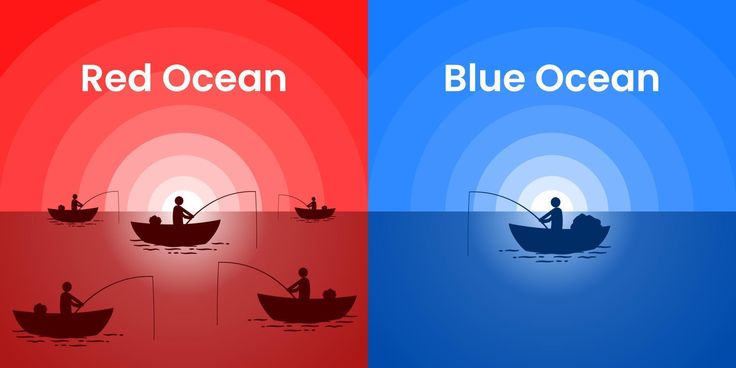Crafting a winning strategy is paramount for businesses aiming for enduring success in today’s fiercely competitive landscape. Two prominent strategies, the Red Ocean Strategy and the Blue Ocean Strategy, have emerged as key approaches in this pursuit. First introduced by W. Chan Kim and Renée Mauborgne in 2004, these strategies offer distinct pathways to carve out market space and drive growth.
Red Ocean Strategy:
The Red Ocean Strategy represents a conventional approach where organizations vie to capture a larger share of existing markets. This strategy unfolds in what can be metaphorically described as a “red ocean,” symbolizing intense competition among rivals for a common customer base. Despite its straightforward nature, the Red Ocean Strategy offers several advantages:
- Participation in established markets
- Direct competition with rival firms
- Leveraging existing market demand
- Comparison of value and cost propositions
- Efficient management of functional systems through strategic choices
How Does Red Ocean Strategy Operate?
To make an impact in a market entrenched in Red Ocean dynamics, companies must introduce market disruptions. This entails offering innovative products or services that stand out amidst the competition, attracting a significant customer base. For instance, Jio, the Indian telecommunications giant led by Mukesh Ambani, shook up the industry by offering free services, disrupting the telecom market landscape.
Similarly, McDonald’s employs a Red Ocean Strategy by discreetly providing affordable burgers while steadily increasing its customer base.
Blue Ocean Strategy:
In contrast, the Blue Ocean Strategy delineates a new market landscape with minimal competition, fostering innovation and growth opportunities. The term “Blue” signifies the vast, unexplored potential of untapped markets.
Benefits of Blue Ocean Strategy:
- Rooted in empirical data
- Redefines industry boundaries
- Emphasizes value and affordability
- Provides a comprehensive framework for experimentation
How Does Blue Ocean Strategy Operate?
Unlike in Red Ocean scenarios, Blue Ocean Strategy eliminates the trade-off between value and affordability for customers. Its focus lies in creating unprecedented value propositions. For example, Facebook’s evolution into Meta exemplifies a transition from Red Ocean to Blue Ocean Strategy. By introducing the concept of the “Metaverse,” Meta has expanded its market scope beyond traditional social media platforms.
Comparing Red Ocean Strategy with Blue Ocean Strategy
| Points of Comparison | Red Ocean Strategy | Blue Ocean Strategy |
| Competition | Higher amount of Competition | The lower range of competition |
| Focus | With the red ocean strategy, organisations are expected to fight the competition with existing services | With the blue ocean strategy, organisations can debut new services emphasising the minimum focus on competition |
| Market Space | Fights in the existing space and with the available service to a bigger rivalry field | Makes a new market space with innovative and new products |
| Customer Value | Competes with its rivals for the existing customer base | Attracts and generate new customers with their brand new product or services |
| Risk | Possesses a higher level of risks | Possesses a lower level of risks |
| Marketing Strategy/Approach | Features a positive, and future-oriented strategy prioritising more growth and opportunities | Features a negative and its primary motive is to defeat its rival organisation |
| Instances | In the era when smartphones were gaining popularity, Apple introduced iPhones attracting a chunk of customers | Coca-Cola’s and Pepsi’s cut-throat competition in the cola market, fighting for a share of the market |
Conclusion:
In devising a potent strategy to enhance business value, both Red Ocean and Blue Ocean Strategies offer transformative potential. While each approach has its merits and drawbacks, selecting the right strategy is crucial for unlocking success. For a detailed understanding of these strategies, refer to our comprehensive guide.

